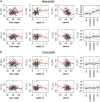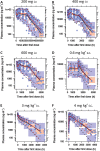A pharmacokinetic comparison of anrukinzumab, an anti- IL-13 monoclonal antibody, among healthy volunteers, asthma and ulcerative colitis patients
- PMID: 25614144
- PMCID: PMC4500329
- DOI: 10.1111/bcp.12589
A pharmacokinetic comparison of anrukinzumab, an anti- IL-13 monoclonal antibody, among healthy volunteers, asthma and ulcerative colitis patients
Abstract
Aims: Anrukinzumab is an anti-IL13 monoclonal antibody. The goals of this study are to characterize the pharmacokinetics of anrukinzumab in healthy volunteers and different disease states and to identify covariates.
Methods: A population pharmacokinetic (PK) model was developed in NONMEM, using data from five clinical studies including healthy volunteers, asthma and ulcerative colitis (UC) patients. Different dosing regimens including different routes of administration were also included in the data.
Results: The PK of anrukinzumab were described by a two compartment model with first order absorption and elimination. The population estimates (relative standard error) of the volumes of distribution in the central (Vc ) and peripheral (Vp ) compartments were 3.8 (4.6%) and 2.2 l (8.7%), respectively. In non-UC patients, the population estimate of the systemic clearance (CL) and inter-compartmental CL was 0.00732 l h(-1) (4.9%) and 0.0224 l h(-1) (15.4%). For subcutaneous administration, the absorption rate constant was 0.012 h(-1) (6.6%) and bioavailability was nearly 100% in healthy and mild to moderate asthma patients. Both V and CL increased with body weight. CL (but not V) decreased with increasing baseline albumin concentrations. UC patients had an increased CL of 72.3% (10.5%), after correction for differences in body weight and albumin. Moderate to severe asthma patients had decreased bioavailability compared with other populations.
Conclusions: Anrukinzumab's PK behave like a typical antibody. UC patients were identified to have a faster CL of anrukinzumab than healthy volunteers and asthma patients. This finding suggests a higher dose level may be required for this population.
Keywords: IL13; IMA-638; NONMEM; anrukinzumab; asthma; healthy volunteers; monoclonal antibody; pharmacokinetics; population PK; ulcerative colitis.
© 2015 The British Pharmacological Society.
Figures





 ,UC;
,UC;  ,non-UC
,non-UCSimilar articles
-
Anrukinzumab, an anti-interleukin 13 monoclonal antibody, in active UC: efficacy and safety from a phase IIa randomised multicentre study.Gut. 2015 Jun;64(6):894-900. doi: 10.1136/gutjnl-2014-308337. Epub 2015 Jan 7. Gut. 2015. PMID: 25567115 Clinical Trial.
-
Population pharmacokinetics-pharmacodynamics of vedolizumab in patients with ulcerative colitis and Crohn's disease.Aliment Pharmacol Ther. 2015 Jul;42(2):188-202. doi: 10.1111/apt.13243. Epub 2015 May 20. Aliment Pharmacol Ther. 2015. PMID: 25996351 Free PMC article. Clinical Trial.
-
Pharmacokinetics and C-reactive protein modelling of anti-interleukin-6 antibody (PF-04236921) in healthy volunteers and patients with autoimmune disease.Br J Clin Pharmacol. 2018 Sep;84(9):2059-2074. doi: 10.1111/bcp.13641. Epub 2018 Jun 25. Br J Clin Pharmacol. 2018. PMID: 29776017 Free PMC article.
-
Population Pharmacokinetics and Pharmacodynamics of Ontamalimab (SHP647), a Fully Human Monoclonal Antibody Against Mucosal Addressin Cell Adhesion Molecule-1 (MAdCAM-1), in Patients With Ulcerative Colitis or Crohn's Disease.J Clin Pharmacol. 2020 Jul;60(7):903-914. doi: 10.1002/jcph.1590. Epub 2020 Mar 2. J Clin Pharmacol. 2020. PMID: 32119128 Free PMC article.
-
A Review of the Clinical Pharmacokinetics, Pharmacodynamics, and Immunogenicity of Vedolizumab.Clin Pharmacokinet. 2017 Nov;56(11):1287-1301. doi: 10.1007/s40262-017-0546-0. Clin Pharmacokinet. 2017. PMID: 28523450 Free PMC article. Review.
Cited by
-
The Possible Roles of IL-4/IL-13 in the Development of Eosinophil-Predominant Severe Asthma.Biomolecules. 2024 May 2;14(5):546. doi: 10.3390/biom14050546. Biomolecules. 2024. PMID: 38785953 Free PMC article. Review.
-
Influence of Antigen Mass on the Pharmacokinetics of Therapeutic Antibodies in Humans.Clin Pharmacokinet. 2019 Feb;58(2):169-187. doi: 10.1007/s40262-018-0680-3. Clin Pharmacokinet. 2019. PMID: 29802542 Review.
-
Targeting IL-13 and IL-4 in Asthma: Therapeutic Implications on Airway Remodeling in Severe Asthma.Clin Rev Allergy Immunol. 2025 Apr 21;68(1):44. doi: 10.1007/s12016-025-09045-2. Clin Rev Allergy Immunol. 2025. PMID: 40257546 Free PMC article. Review.
-
Dose escalation randomised study of efmarodocokin alfa in healthy volunteers and patients with ulcerative colitis.Gut. 2023 Aug;72(8):1451-1461. doi: 10.1136/gutjnl-2022-328387. Epub 2023 Feb 2. Gut. 2023. PMID: 36732049 Free PMC article. Clinical Trial.
-
Base and Covariate Population Pharmacokinetic Analyses of Dupilumab Using Phase 3 Data.Clin Pharmacol Drug Dev. 2020 Aug;9(6):756-767. doi: 10.1002/cpdd.780. Epub 2020 Feb 25. Clin Pharmacol Drug Dev. 2020. PMID: 32096596 Free PMC article.
References
-
- Wynn TA. IL-13 effector functions. Annu Rev Immunol. 2003;21:425–56. - PubMed
-
- Neurath MF, Finotto S, Glimcher LH. The role of Th1/Th2 polarization in mucosal immunity. Nat Med. 2002;8:567–73. - PubMed
-
- Kasaian MT, Miller DK. IL-13 as a therapeutic target for respiratory disease. Biochem Pharmacol. 2008;76:147–55. - PubMed
-
- McMahan ZH. Wigley FM. Vol. 23. Expert Opin Investig Drugs: Novel investigational agents for the treatment of scleroderma; 2014. pp. 183–98. - PubMed
Publication types
MeSH terms
Substances
LinkOut - more resources
Full Text Sources
Other Literature Sources
Medical

